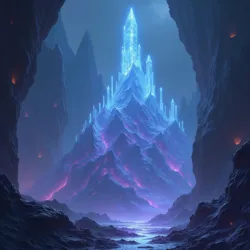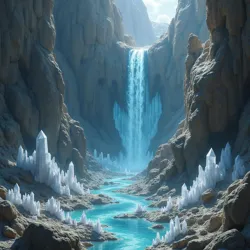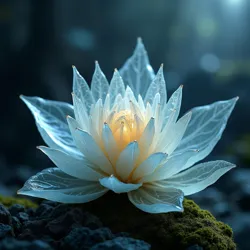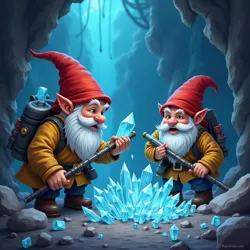Crystal Peaks

Visually striking sub-range within the Fellreeves Mountains, known for crystalline formations and soft luminescence in the Underdark.
Northwestern Underdark
Crystalline formations, luminescence
Quartz, amethyst, gem-trading
Hydrothermal activity, mineral-rich groundwater
Bioluminescent lichen, triboluminescent crystals
Nigritude gnomes, Under-mountain folk, Drow
Crystal mining
Crystalline Whisperwind Plant, Glowcap Fungus
The *Crystal Peaks, sometimes referred to as the Shimmering Summits* by Under-mountain folk, are a visually striking sub-range within the larger Fellreeves Mountains, located in the northwestern Underdark. Distinguished by their abundance of crystalline formations and a pervasive, soft luminescence, the Crystal Peaks are a geological marvel and a region of significant ecological, cultural, and economic importance within the subterranean world. Unlike the jagged, iron-rich peaks of the central Fellreeves, the Crystal Peaks are characterized by gentler slopes and an ethereal glow, making them a unique and recognizable landmark. They are renowned for their extensive veins of quartz, amethyst, and other semi-precious crystals, which not only give the peaks their name but also influence the local environment and the cultures that have arisen around them. The Crystal Peaks are a place of both stark beauty and hidden dangers, interwoven with Underdark lore and playing a crucial role in the alchemical and gem-trading networks of the region.
Geology and Formation
The geological formation of the Crystal Peaks is closely linked to the broader tectonic and volcanic history of the Fellreeves Mountains, yet they possess distinct characteristics that set them apart. While the Fellreeves in general are a product of ancient plate collisions and volcanic upwelling, the Crystal Peaks owe their unique features to a specific combination of hydrothermal activity and mineral-rich groundwater. Geological studies, primarily conducted by nigritude gnome scholars and Under-mountain folk geomancers, suggest that the Crystal Peaks are situated over a region of particularly intense geothermal activity, where superheated water, rich in dissolved silica and various trace minerals, has been circulating through fissures and fractures in the bedrock for eons. This hydrothermal fluid, as it slowly cooled and interacted with the surrounding rock formations, precipitated out its mineral content, leading to the extensive crystallization that defines the region.
 Vast network of quartz veins permeating rock strata, with formations like geodes and stalactites in the Crystal Peaks.
Vast network of quartz veins permeating rock strata, with formations like geodes and stalactites in the Crystal Peaks.Crystal Veins and Formations
The most prominent geological feature of the Crystal Peaks is the vast network of crystal veins that permeate the rock strata. These veins, ranging in size from hairline fractures filled with microscopic crystals to massive seams several meters wide, are composed primarily of quartz in various forms, including clear quartz, amethyst, rose quartz, and smoky quartz. The coloration and variety of quartz crystals are attributed to the presence of trace minerals within the hydrothermal fluids, such as iron, manganese, and titanium, which impart different hues to the crystalline structures. In addition to quartz, veins of other semi-precious crystals, such as agate, chalcedony, and jasper, are also found within the Crystal Peaks, though in lesser quantities.
The crystals themselves exhibit a wide range of formations, from euhedral crystals with well-defined faces to massive, interlocking aggregates. Geodes, hollow cavities within the rock lined with inward-growing crystals, are particularly common in the Crystal Peaks, often discovered by miners and prized for their beauty and crystalline perfection. Stalactites and stalagmites composed of crystalline materials also adorn many of the caverns within the peaks, creating dazzling subterranean landscapes. The density and concentration of crystal veins vary across the Crystal Peaks, with some areas being almost solid masses of intergrown crystals, while others exhibit more scattered and isolated formations. This variability influences mining operations and the distribution of crystal-adapted ecosystems.
Luminescence and Light Phenomena
A defining characteristic of the Crystal Peaks is their soft, pervasive luminescence. This glow is not attributed to a single source but rather to a combination of factors, primarily involving the interaction of phosphorescent cave lichen and the optical properties of the crystals themselves. Certain species of cave lichen, unique to the Crystal Peaks environment, possess bioluminescent properties, emitting a faint, greenish-blue light. These lichens colonize the surfaces of rocks and crystals, particularly in areas with higher humidity and airflow. The light emitted by the lichen is then refracted and scattered by the numerous crystal surfaces, creating a diffuse, ethereal glow that permeates the caverns and even filters out into the surrounding areas.
Furthermore, some of the crystals themselves exhibit triboluminescence, emitting flashes of light when mechanically stressed or fractured. Mining activities and natural rock movements can trigger this phenomenon, adding to the overall luminescence of the Crystal Peaks, particularly in deeper caverns where external light sources are completely absent. The combination of bioluminescent lichen and triboluminescent crystals creates a unique light environment within the Crystal Peaks, influencing the behavior of local fauna and contributing to the region's mystical reputation. This natural illumination, while dim compared to surface sunlight, is sufficient to allow for limited visibility and supports a unique subterranean ecosystem adapted to this peculiar light regime.
Cave Systems within the Peaks
Like the broader Fellreeves range, the Crystal Peaks are riddled with extensive cave systems. However, the caverns within the Crystal Peaks are distinguished by their crystalline formations and the pervasive luminescence. Hydrothermal activity, in addition to forming crystal veins, has also played a role in carving out these cave systems, dissolving soluble rock layers and creating intricate networks of tunnels and chambers. Many of these caverns are adorned with spectacular crystal formations, including crystal curtains, helictites, and cave pearls composed of crystalline materials. The air within the Crystal Peaks caverns is often saturated with moisture, further enhancing the growth of bioluminescent lichen and contributing to the overall humidity levels.
Some of the deeper caverns within the Crystal Peaks are known to be geothermally active, with hot springs and fumaroles venting steam and mineral-rich gases. These geothermal features support unique thermophilic ecosystems and contribute to the ongoing mineral deposition processes within the caves. Navigating the cave systems of the Crystal Peaks can be challenging due to the slippery crystal surfaces and the labyrinthine nature of the tunnels, but the visual splendor of the crystalline environments and the potential for discovering valuable crystal deposits make exploration a worthwhile endeavor for adventurers and miners alike.
Ecology and Unique Flora/Fauna
The distinctive geological environment of the Crystal Peaks has fostered a unique and specialized ecosystem, characterized by flora and fauna adapted to crystal-rich substrates, low-light conditions, and the pervasive luminescence. While sharing some similarities with the broader Fellreeves subterranean ecology, the Crystal Peaks host endemic species and ecological interactions that are specific to this crystalline environment.
 Translucent crystalline leaves of the fictional Whisperwind Plant thriving in the dimly lit, crystal-rich environment of the peaks.
Translucent crystalline leaves of the fictional Whisperwind Plant thriving in the dimly lit, crystal-rich environment of the peaks.Crystal-Adapted Flora
Plant life in the Crystal Peaks, while sparse compared to surface ecosystems, is uniquely adapted to the mineral-rich and dimly lit environment. The dominant plant forms are various types of fungi and lichens, particularly the bioluminescent species that contribute to the peaks' glow. Among the more notable flora is the Crystalline Whisperwind Plant (Crystalliflora murmuris), a fictional species of vascular plant that has evolved to thrive in crystal-rich soils. This plant is characterized by its translucent, crystalline leaves, which are thought to aid in light capture and reflection in the dimly lit caverns. The Whisperwind Plant derives its name from the gentle rustling sound its crystalline leaves produce in even the slightest air currents, creating a subtle, ethereal ambiance within the Crystal Peaks caves. It is believed to obtain nutrients not only from the soil but also from mineral uptake through its crystalline leaves, a unique adaptation to the nutrient-poor environment.
Another notable fungal species is the Glowcap Fungus (Luminomyces crystallophilus), a bioluminescent fungus that grows exclusively on crystal surfaces. Unlike the lichen, the Glowcap Fungus emits a brighter, more localized light, often forming clusters of luminous caps on crystal outcroppings. Its light is thought to attract cave insects, which aid in spore dispersal. Various types of mosses and liverworts, tolerant of low-light and mineral-rich conditions, also contribute to the plant diversity of the Crystal Peaks, forming mats and carpets on rock surfaces and crystal formations. These plant communities, while seemingly simple, form the base of the food web for the Crystal Peaks ecosystem, supporting a specialized fauna.
Crystalline Fauna
The fauna of the Crystal Peaks is equally adapted to the unique crystalline environment. Cave insects, arachnids, and crustaceans are abundant, many exhibiting adaptations to the dim light and mineral-rich conditions. A particularly noteworthy species is the Troglobium Crystallis Beetle (Troglobium crystallis), a fictional cave beetle endemic to the Crystal Peaks. This beetle is characterized by its transparent exoskeleton, which allows its internal organs and crystalline structures within its body to be visible. The Troglobium Crystallis beetle feeds on the Glowcap Fungus and decaying plant matter, playing a crucial role in nutrient cycling within the Crystal Peaks ecosystem. Its transparent exoskeleton is thought to be an adaptation for camouflage in the crystalline environment, as well as potentially allowing for some degree of light absorption or reflection.
Cave spiders, scorpions, and millipedes, adapted to the low-light and humid conditions, are also common inhabitants of the Crystal Peaks caverns. Many of these species exhibit pale coloration and reduced or absent eyes, relying on other senses such as touch and chemoreception to navigate and hunt. Vertebrate life is less abundant but includes cave salamanders and bats that utilize the Crystal Peaks caverns for shelter and foraging. The Fellreeves Cave Salamander, while not exclusive to the Crystal Peaks, is found in higher densities in this region due to the abundance of cave insects and suitable habitat. Bat species, adapted to subterranean life, roost in the larger caverns and emerge to hunt insects in the broader Fellreeves region, contributing to nutrient exchange between the Crystal Peaks and surrounding areas.
Symbiotic Relationships
Symbiotic relationships are prevalent within the Crystal Peaks ecosystem, reflecting the specialized nature of the environment and the close interdependencies between species. The relationship between the Glowcap Fungus and the Troglobium Crystallis beetle is a prime example of mutualism, where the fungus benefits from spore dispersal by the beetle, and the beetle gains a food source. The bioluminescent lichen and the Crystalline Whisperwind Plant may also exhibit a form of commensalism, where the lichen benefits from the plant's structure for support and access to humidity, while the plant is unaffected or potentially benefits from the lichen's luminescence in attracting pollinators (if any exist in this environment).
Mycorrhizal associations, symbiotic relationships between fungi and plant roots, are likely to be common in the Crystal Peaks, aiding plants in nutrient uptake from the mineral-rich but often nutrient-poor soils. Cave insects and arachnids may also host symbiotic bacteria or fungi within their digestive systems, aiding in the breakdown of complex organic matter in the nutrient-scarce cave environment. These symbiotic interactions highlight the intricate web of life within the Crystal Peaks and the evolutionary adaptations that have allowed species to thrive in this unique subterranean environment.
Inhabitants and Culture
The Crystal Peaks, while not as densely populated as some other regions of the Fellreeves, have been inhabited and utilized by various cultures throughout history, drawn to their mineral wealth, unique environment, and mystical allure. Gnomes, particularly Nigritude Gnomes, and Under-mountain folk are the primary inhabitants, with Drow influence also present, particularly in relation to crystal resources.
 Gnome miners extracting crystals with specialized tools and techniques in the cavernous Crystal Peaks.
Gnome miners extracting crystals with specialized tools and techniques in the cavernous Crystal Peaks.Gnome Crystal Miners
Nigritude gnomes have a long and deep connection to the Crystal Peaks, considering them a region of both great economic opportunity and spiritual significance. Gnome communities, often organized into mining guilds, are scattered throughout the Crystal Peaks, centered around rich crystal veins and accessible cave systems. Gnome miners are renowned for their expertise in crystal extraction, utilizing specialized tools and techniques to carefully excavate crystals without damaging their delicate structures. They have developed intricate methods for navigating the labyrinthine caverns, often employing bioluminescent markers and acoustic signals to orient themselves in the dimly lit environment.
Gnome culture in the Crystal Peaks is heavily influenced by the crystalline environment. Their architecture often incorporates crystals, both for structural and decorative purposes. Gnome artisans are skilled in gem-cutting and crystal crafting, transforming raw crystals into jewelry, ornamental objects, and alchemical tools. Crystal-themed motifs are prevalent in gnome art, folklore, and religious beliefs. The gnomes of the Crystal Peaks have a deep respect for the mountains and their crystalline treasures, often incorporating conservation practices into their mining operations to ensure the long-term sustainability of crystal resources. They also possess a vast knowledge of the local flora and fauna, utilizing various plants and fungi for medicinal and practical purposes.
Under-mountain Folk Lore
Under-mountain folk communities also inhabit the Crystal Peaks, though often in smaller numbers and more dispersed settlements compared to the gnomes. For Under-mountain folk, the Crystal Peaks hold a significant place in their folklore and mythology, viewed as sacred grounds and places of mystical power. They associate the luminescence of the peaks with ancient spirits and subterranean deities, incorporating crystal imagery into their religious rituals and spiritual practices. Under-mountain folk often act as guides and protectors of the Crystal Peaks, possessing a deep understanding of the mountains' hidden pathways, dangers, and ecological balance.
Their settlements in the Crystal Peaks are often more integrated with the natural cave environment, utilizing natural caverns and rock shelters for dwellings rather than constructing elaborate structures. Under-mountain folk artisans are skilled in crafting tools and ornaments from local materials, including crystals, bones, and cave flora. They maintain a close relationship with the gnome miners, often engaging in trade and cultural exchange. Underdark Folklore of the Crystal Peaks is rich with tales of crystal spirits, hidden crystal cities, and legendary crystal creatures, reflecting the awe and wonder inspired by this unique subterranean region.
Drow Interest and Conflict
Drow influence in the Crystal Peaks is primarily driven by their interest in crystal resources, particularly high-quality gemstones and crystals with potential alchemical applications. Drow noble houses have established mining outposts and trading enclaves in the Crystal Peaks, often seeking to control crystal extraction and trade routes. This Drow presence has led to territorial disputes and conflicts with both gnome and Under-mountain folk communities, who resent Drow encroachment and resource exploitation.
Drow interactions with the inhabitants of the Crystal Peaks are often characterized by a mixture of coercion, negotiation, and outright hostility. Drow mercenaries and overseers are employed to manage mining operations and enforce Drow claims, sometimes leading to clashes with gnome mining guilds and Under-mountain protectors. However, Drow merchants also engage in trade with gnome and Under-mountain communities, exchanging surface goods and Drow-crafted items for crystals and other subterranean resources. The presence of Drow in the Crystal Peaks adds a layer of political complexity and potential danger to the region, as competing factions vie for control over valuable crystal deposits and strategic locations within the mountains. The allure of crystals, coupled with the Drow's expansionist tendencies, ensures that their presence in the Crystal Peaks remains a significant factor in the region's cultural and economic landscape.
Resources and Economic Significance
The Crystal Peaks are a vital economic region within the Fellreeves and the broader Underdark, primarily due to their rich crystal deposits. Crystal mining is the dominant industry, but other resources and related industries also contribute to the region's economic prosperity.
Crystal Mining Industry
Crystal mining is the lifeblood of the Crystal Peaks economy. The abundance of high-quality quartz, amethyst, and other semi-precious crystals has made the region a major source of gemstones and crystalline materials for the Underdark and beyond. Gnome mining guilds are the primary players in the crystal mining industry, controlling many of the most productive mines and employing specialized mining techniques. Mining operations range from small-scale, artisanal digs to larger, organized mining complexes, often utilizing complex tunnel networks and extraction machinery.
The types of crystals mined in the Crystal Peaks are diverse, catering to various markets and applications. Clear quartz crystals are highly valued for their clarity and purity, used in jewelry, optical devices, and alchemical apparatus. Amethyst crystals, prized for their vibrant purple color, are used in jewelry, ornamental objects, and believed to possess mystical properties. Smoky quartz, rose quartz, and other colored varieties also find applications in jewelry and decorative arts. Larger, flawless crystals are particularly valuable, sought after by collectors, nobles, and alchemists. The crystal mining industry not only provides raw materials but also supports a thriving gem-cutting and crystal crafting sector within the Crystal Peaks and surrounding regions.
Alchemical Applications
Crystals from the Crystal Peaks are believed to possess unique alchemical properties, making them sought after ingredients in various alchemical formulations and processes. Clear quartz crystals are thought to enhance clarity and focus in alchemical operations, used in distillation apparatus and potion brewing. Amethyst crystals are associated with calming and purifying properties, incorporated into elixirs and potions aimed at mental clarity and emotional balance. Certain rare crystal formations from the Crystal Peaks are rumored to possess potent magical energies, used in the creation of enchanted items and powerful potions.
While not directly linked to Claus Jabbers and his pheromone philtres, some alchemists speculate that certain crystal essences, extracted from Crystal Peaks crystals, might possess subtle pheromonal properties or enhance the effects of pheromone-based concoctions. This potential alchemical significance adds to the value and demand for Crystal Peaks crystals, further driving the mining industry and trade networks associated with the region. Gnome alchemists, in particular, are known for their expertise in utilizing Crystal Peaks crystals in their alchemical practices, developing unique techniques for extracting and harnessing their purported properties.
Trade Routes and Commerce
The Crystal Peaks are strategically located along established Underdark trade routes, facilitating the flow of crystal resources and related goods to distant markets. Caravan routes, traversing mountain passes and subterranean tunnels, connect the Crystal Peaks to other regions of the Fellreeves and beyond. Subterranean waterways also serve as important trade arteries, allowing for the transport of bulk crystal shipments and other commodities. Gnome merchants and Under-mountain traders play a crucial role in Crystal Peaks commerce, operating trading posts, caravans, and subterranean markets. They facilitate the exchange of crystals for food, tools, textiles, and other goods from both surface and subterranean sources.
Drow merchants, representing powerful noble houses, also participate in Crystal Peaks trade, often controlling long-distance trade routes and dealing in high-value crystal shipments. The competition for control over trade routes and crystal markets is a source of ongoing tension and occasional conflict between different factions. The bustling trade networks of the Crystal Peaks not only contribute to the region's economic prosperity but also foster cultural exchange and interaction among diverse Underdark communities, making the Crystal Peaks a vibrant hub of commerce and cultural intersection within the subterranean world.
Legends and Mysteries
The Crystal Peaks, with their unique geological features, luminescent caverns, and isolated locations, are shrouded in legends and mysteries, fueling folklore, inspiring tales of adventure, and attracting explorers seeking the unknown.
Crystal Wyrm Legends
Fellreeves folklore mentions Crystal Wyrms as serpentine creatures with scales composed of shimmering crystals, rumored to dwell in the mineral-rich caverns, guarding gemstone veins and hoarding treasure. In the Crystal Peaks, these legends are particularly prominent, with tales of colossal Crystal Wyrms inhabiting the deepest and most inaccessible caverns. These wyrms are depicted as guardians of immense crystal hoards, their scales radiating blinding light and their breath capable of petrifying intruders.
Crystal Wyrm legends often serve as cautionary tales, warning miners and treasure-seekers against greed and recklessness in their pursuit of crystals. However, they also fuel the imagination of adventurers and treasure hunters, who dream of discovering a Crystal Wyrm's lair and claiming its hoard. Some Under-mountain folk believe that Crystal Wyrms are not merely mythical creatures but ancient spirits of the mountains, embodying the crystalline energy of the peaks and protecting their sacred treasures. These legends contribute to the mystique and perceived danger of the Crystal Peaks, adding an element of fantastical peril to exploration and mining activities.
Lost Crystal Cities
Another prevalent legend in the Crystal Peaks is the existence of Lost Crystal Cities, ancient civilizations said to have been built entirely from or around naturally occurring crystal formations. These cities are often depicted as architectural marvels, their buildings crafted from massive crystal blocks, their streets paved with shimmering gemstones, and their interiors illuminated by naturally luminescent crystals. Legends vary as to the fate of these crystal cities, some claiming they were abandoned due to geological upheavals or magical catastrophes, others suggesting they remain hidden, protected by ancient enchantments or concealed within unexplored caverns.
The allure of discovering a lost crystal city is a powerful motivator for explorers and archaeologists venturing into the Crystal Peaks. Rumors of hidden entrances, cryptic maps, and ancient clues fuel the search for these mythical metropolises. Some believe that these lost cities hold vast stores of knowledge, advanced technologies, or powerful magical artifacts, making their discovery a potentially transformative event for Underdark society. While no concrete evidence of such cities has ever been found, the persistence of these legends underscores the enduring mystery and unexplored potential of the Crystal Peaks.
Unexplained Luminescent Phenomena
Beyond the known sources of luminescence in the Crystal Peaks – bioluminescent lichen and triboluminescent crystals – there are persistent accounts of unexplained light phenomena, further adding to the region's mystique. Miners and explorers occasionally report sightings of shifting lights, ethereal glows that move and change color inexplicably within the caverns. These lights are sometimes attributed to magical effects, subterranean spirits, or unknown geological processes. Some believe they are manifestations of the mountains' crystalline energy, while others speculate they are illusions or mirages caused by unusual atmospheric conditions within the caves.
Another unexplained phenomenon is the occurrence of crystal resonance, where certain crystal formations are said to emit harmonic vibrations or pulses of light under specific conditions. These resonance effects are often associated with areas of high crystal concentration or geothermal activity, suggesting a possible link to geological forces. While scientific explanations for these phenomena are lacking, their persistent occurrence in local accounts and folklore contributes to the perception of the Crystal Peaks as a place of wonder, mystery, and unexplained energies, further enhancing their cultural and legendary significance.